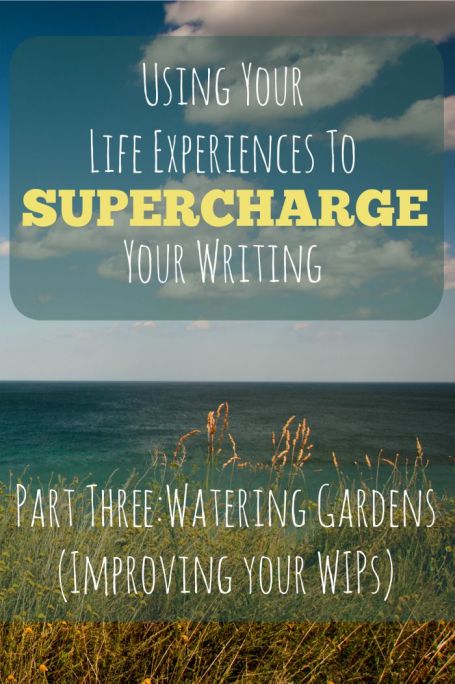Hey Everyone!
So, this is the third and final part of Using Life Experiences to Supercharge Your Writing! Isn’t that exciting? If you’re feeling a little confused, why don’t you start by learning about all the amazing experiences you have to put into your writing by exploring your experience pool in Part One. If you want to learn how to use these experiences to create some awesome story ideas, head over to Part Two. If you already have a WIP, and want to find ways to make your characters and scenes more realistic, you’re in the right spot! These steps will usually work best if you have a completed draft to work with, but that might just be the way I go through my process, so if you’re really struggling with something, go ahead and use these steps and see what happens!
 Watering Your WIP Garden
Watering Your WIP Garden
Step One: Surveying Your Garden
Just like the first two parts of the Using Life Experiences series, I have an awesome water-related metaphor for you: watering a garden. Each plant in your garden is a different scene or character in your WIP, and each one of those needs special care to become the biggest, healthiest and most reader-captivating it can. Figuring out what kind of care each part of your story needs is the first step to figuring out exactly how to make it amazing.
Get to the Root of the Matter
What aspects of your story have their roots in your own life? Maybe there’s a character whose parental situation is similar to your own, or there’s a scene that echoes back to a pivotal one in your own life. I’m sure you’ll be quite surprised at how many connections you find once you start digging. If you want help, enlisting a friend to read your piece over to find similarities, or just talking to them about your story is a huge help.
These similarities aren’t always direct. The feeling of having a distant parent is shared between a writer with an alcoholic mother and a character whose driven mother very rarely takes time away from her work. The goal is to find parts of your work with roots in your experiences, regardless of what they morph into later on.
Examine the Dry Spots
Find parts of your writing where things are falling flat. There might be a scene that needs to have a bigger emotional impact, or a character whose personality isn’t shining through the way you imagined it. Write down or highlight excerpts that are frustrating you, and try brainstorming a few reasons why. Do you need to add more emotional detail to that big argument? Is there a character being pushed into the background because they lack a compelling motivation or personality? I recommend selecting just one problem area to work on as we move forward in this process to avoid getting overwhelmed.
Step Two: Selecting Your Fertilizer
Alright, now that we’ve learned about what inspiration we’ve already drawn from our experience pools, and found some areas of our writing that might need a bit of help, it’s time to figure out what our WIP Garden actually needs to grow into its full potential.
Figure Out Your Plant’s Needs
Compare your problem area to one of the stronger sections of your story, focusing on what makes one more compelling than the other. Does one character have a memorable quirk or a certain worldview that makes their actions more intriguing or surprising? What emotional details does your favorite scene from your story have that your dry spot doesn’t? Take pieces out from your stronger scenes, and see what changes make that scene suddenly fall apart.If there’s a scene or character from another work that is similar to what you want your problem spot to look like, try looking at that as well. What techniques do the other author use that you might be able replicate?
This step is a great one to work through with a writing buddy. Ask them to read your stronger scene first, highlighting details or sections that move them, and then show them the problem section. Have a conversation about what your reader wants to see more of.
 Mix Your Ingredients
Mix Your Ingredients
Now that we know what went wrong with a particular scene, it’s time to head over to our experience pool and find a way to fix it. This means doing a bit of brainstorming, so I hope you have a blank page ready! If you wrote down your answers to the experience pool questions from Part One, it might be helpful to have those on hand as well.
Working With A Scene
Start by trying to place yourself into a particular scene or situation that you’re struggling with.Close your eye and really focus on what you notice. What do your characters look like? What are your senses telling you? Write down as many of these details as you can within a 5 minute period, noting as much as you can about your setting and your characters as you can.
Next, look at some of your own experiences that might have a similar mood to them and go through the same process. What do you remember most? Are there odd details that still sticks out to you? Is there an emotion attached to these details? Try finding similarities or patterns between the two lists, and cross off any details that you don’t believe will help create a more compelling story for your readers.
Working With a Character
Start by visualizing your character and noting as many details about them as you can. How do they walk, talk and dress? Do they have any physical features that stand out? Work for about five minutes to create a solid list of outside details, focusing on finding ones that will make your character stand out from the others in your story.
Next, look at your character’s personality and background. You don’t need to write out an in-depth psychoanalysis or their entire life story, but make sure you are able to pull out some details that will help your understand your character. If you can’t, you might have a lot more work ahead than you imagined, or you might simply have to remove the character altogether.
Now, think about the memorable people in your life, or anyone who you feel an emotional connection to. How do you feel about them? What aspects of their personality make them interesting to you and others? Think about things like their outlooks and histories and jot down details you think you could apply to the character you’re working on. Using the three lists you’ve made, come up with details that will help you make your character more interesting to readers, like bits of dialogue, characters quirks, or new personality traits and histories.
Step Three: WIP Watering for Beginners
This step might be the easiest to explain, but the hardest to execute. We’ve identified where our problems are, and brainstormed ways to fix them. Now, all we have left to do is start using our ideas to make supercharge our writing and make our readers truly invest into our scenes and characters.
Working With a Character
Depending on where the process in Step Two led you, you might be finding yourself with some very small or very dramatic changes in your problematic character. Regardless of how much your vision has changed, the only way your reader is going to know about it is if you change the way you’re portraying them in your writing. Because of this, I suggest choosing either the first or the most pivotal scene your character appears in, and then following the steps for working with a scene below, then going through other scenes with that character continuing the process.
Working With a Scene
Start adding in your details, experiment with which details you add where, and how you describe them. Focus on the emotional relevance of each detail when you’re inserting it. Is there something a character become fixated on that has a deeper meaning? What does the body language of your characters say that they might not want to? If you can, try changing the setting of your scene, even if you think that it couldn’t occur anywhere else. Refer back to your own memories as you go, thinking about the emotional impact that certain places have had on your life. Experiment with changing other aspects of the scene as well, like the characters involved and what’s going on around them.
This might take some time, so make sure you take breaks so that you don’t lose your focus. Having another person come in and read different versions of your scene is another great way to get fresh eyes on your work, and they might be able to offer ideas you would have never thought of. Also be careful to keep track of your changes and have different copies of your work available to compare. If you’re on the computer, this is where the “Save As” button comes in handy, as well as the highlighter tool, which you can use to point out the changes you’ve made from one draft to another.
Avoid Overwatering
You might be tempted to simply shove in as many extra details as you can into each scene, but that is not the best idea. Having too many details is distracting to your reader, and may muddle the point of the scene. If you’re concerned that you’re adding too many details, ask yourself these questions:
- Does this detail have a strong emotion attached to it?
- Does it contribute to the overall mood of the scene?
- Does it give a new insight into a character’s personality?
- Does the scene read seamlessly with this detail included?
- Does the reader need to know this detail now, or is there a better place in my story for it?
Advanced Watering Techniques
Now that you have the process down, it’s time to really kick things up a notch so that you can become a pro at using details from your life to supercharge your works in progress.
Cross-Pollination
I know I’ve already talked about this in all of my posts, but working with other writers is one of the best ways I know to improve your writing skills. Whether this is through critiquing their work, or receiving advice about your own, having a circle of writer friends is like tapping into a pool of experiences that you may never have access to otherwise.
Even non-writers are a great tool for finding details to add to your story, If you’re having a hard time figuring out how a certain character would do or say something, find someone in your life who shares some of their prominent personality traits and talk to them about the situation. If you’re shy about your writing, it’s totally okay to talk about these things in hypotheticals, but I don’t think you have anything to feel shy about. You’re pretty great, after all.
Pulling Out the Weeds
If your work is feeling a little cluttered, or there’s a lot of dry characters or lagging scenes in your story, it might be time to consider pulling out some unnecessary pieces. I know it’s painful after working so hard to make something work, but a desert cactus doesn’t belong in a rainforest, and no amount of work you can do can change that. Maybe someday in the future, you’ll find a place for that character or scene, but today is just not it.

Whew! This is it for the last post in my “Using Life Experiences” series! I have to say that I am really proud of how this turned out, and I really hope that everyone who reads any of these posts will be able to learn just one thing that will make their writing better. I’d prefer to have all of you learn boatloads, but even one thing would make me the happiest blogger ever. If you have any suggestions, feel free to comment below, or to e-mail me at SpunFromInk@gmail.com.
What do you do with the problem areas in your WIPs? What parts of your story already had roots in your life? Share your responses below, then make sure to spread the love on twitter by sharing and following @SpunFromInk. Have an awesome day, everyone!
Love,
Nicole



